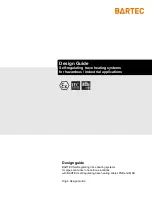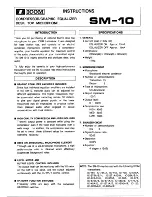
1
1
INTRODUCTION
The SM30 sound management system
provides an ideal solution for public address
distribution systems, requiring a compact
and flexible set-up with ease of operation.
Being controlled by a microprocessor, the
system is particularly flexible, specific
functions being easily made and changed by
non technical personnel. In order to meet
differing application needs a variety of
plug-in modules are available, and a wide
range of system configurations are possible.
The total public address distribution system
comprises:
■
One Control Centre, containing a
microprocessor and plug-in modules.
■
SM30 Call stations.
■
Power amplifiers which feed loudspeakers
located in geographical and/or functional
zones where people must be reached with
background music, announcements, pre-
recorded messages, and alarm signals.
A maximum of 6 Call Stations may be used,
their functions being programmed from a
keyboard and display unit built into the
Control Centre. The system is designed to
handle calls and music simultaneously, so
that if a call is made to a particular zone or
combination of zones, music playing in
other zones will not be interrupted. A
system of priorities has been developed to
cope with conflict situations, for example a
person attempting to make a call when
another call is being made by someone with
a higher priority, the new call will not be
switched through.
Control Centre
At the heart of each SM30 system is the
Control Centre. This is a self contained
unit, housing the microprocessor which
controls SM30, and 12 slots which hold the
plug-in modules.
On the front panel of the Control Centre
are programming keys and associated LEDs,
an alpha-numeric LCD display, and keys for
controlling the functions of the music source
inputs. The programming keys enable the
installer to program SM30 to suit the overall
system configuration, and the user’s specific
needs. To allow the operator to control the
music sources, four Music Function Keys are
provided on the front panel.
These keys allow the operator to select the
music source; alter the music volume level
up or down; and mute the music signal.
Programming
The displays and the programming menus
are presented in the selected language. In the
normal ‘run’ mode of the system, the LCD
display indicates the name of the current
music source (e.g. “TUNER”, or “MUSIC
OFF”), plus the current music volume level.
In the ‘programming’ mode, the display will
enable the installer/user to see:
■
Program selections while scrolling
through the programming menus.
■
Function selections within a program.
■
The number of the current Call Station;
Function Key; Microphone; Control
Inputs; etc., being programmed.
■
Call priority status.
■
Attention or Alarm signal number.
■
Pre-recorded message number.
■
Loudspeaker Zone call; Control Relay;
and music routing.
■
Alternative Function Key functions.
■
Alternative Music Input text.
■
Current program status (e.g. CLEARING
MEMORY PLEASE WAIT).
■
‘Error’ indications.
■
Language selection.
■
Alarm interruption.
■
Power-on delay.
GB/SM 30 user manual 5/26/98 10:17 AM Page 1
Содержание SM30
Страница 1: ...Philips Communication Security Systems SM30 Sound Management System User Manual LBB 1280 User Manual ...
Страница 18: ...16 1 3 1 3 C C SQ45 SM30 4 X Fig 5 5 1 Two channel system ...
Страница 19: ...17 1 1 3 C SQ45 SM30 Fig 5 5 2 One channel system ...
Страница 50: ...48 ...
Страница 52: ...CONTENTS page 14 5 Summary SM 30 installer programming 1 14 6 Setup programming 3 14 7 Installer programming 3 ...
Страница 70: ......
Страница 71: ......
Страница 72: ...Data subject to changes without notice Printed in the Netherlands 3922 988 33415 20 97 ...




































